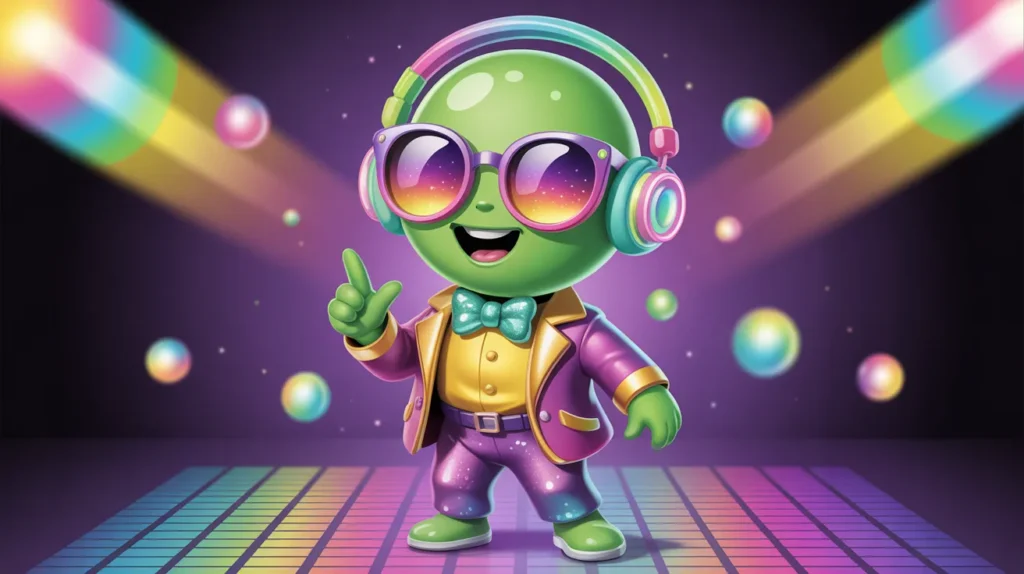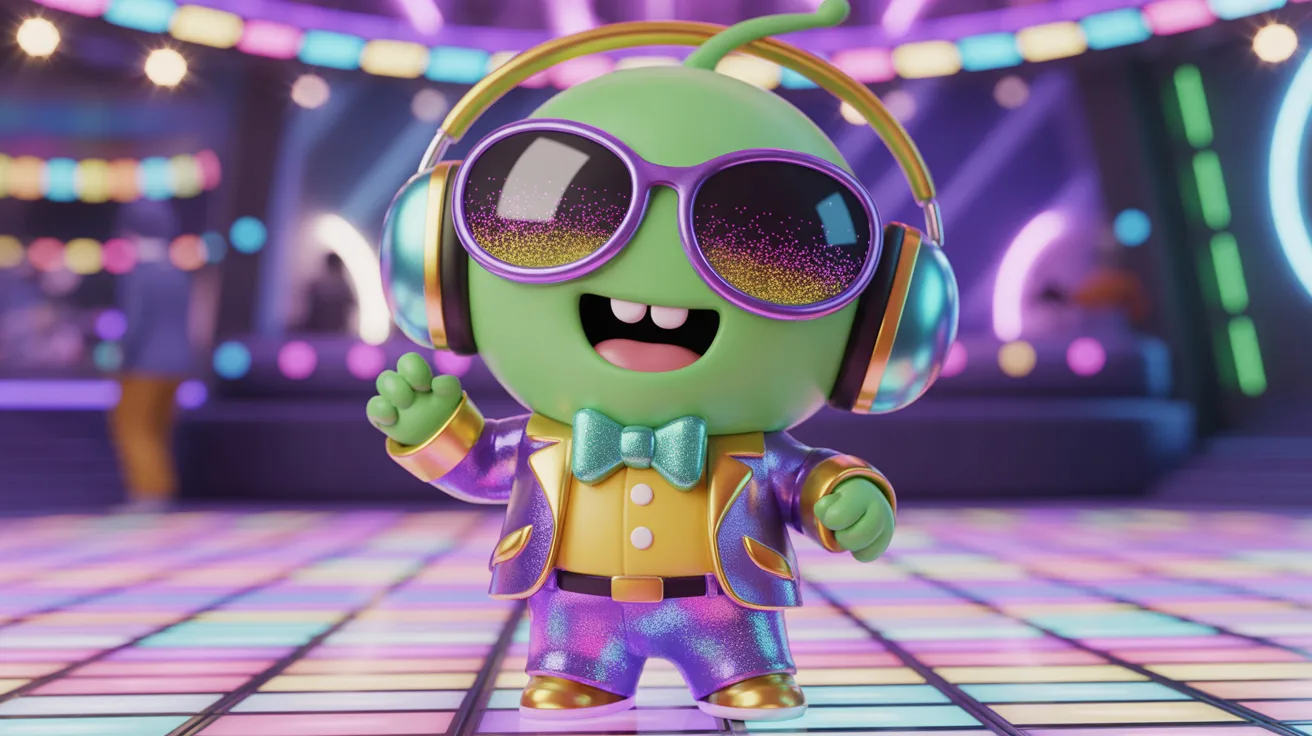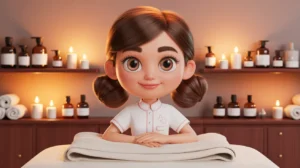Let’s Boogie Down to Comedy Town 🕺
Picture this: It’s 1977, and you’re stepping onto a pulsating dance floor bathed in multicolored lights. The mirror ball spins overhead, casting dancing diamonds across platform shoes and bell-bottoms. The bass line thumps through your chest as the DJ drops another funky beat. This is Disco Puns and Jokes—the era that made Saturday nights legendary!
Disco dominated the music scene from the mid-1970s to early 1980s, selling over 4 million records weekly at its peak. The genre originated in underground clubs where marginalized communities—particularly Black, Latino, and LGBTQ+ folks—created a safe space for expression and joy. Studio 54 in New York became the epicenter of disco culture, where celebrities and everyday people alike grooved under the famous mirror ball.
The term “disco” comes from “discothèque,” French for a nightclub with recorded music. These venues featured legendary DJs who mixed records seamlessly, creating continuous dance experiences. The mirror ball, invented in the 1920s but perfected in the disco era, became the genre’s most iconic symbol.
Though some declared “Disco is dead” after the infamous 1979 Disco Demolition Night, the genre’s influence never truly faded. Today, disco inspires modern pop, electronic music, and countless dance parties. So slip on your dancing shoes, adjust that polyester jumpsuit, and prepare to groove through the most dazzling collection of disco puns this side of the Bee Gees!
🪩 Classic Disco Puns: Stayin’ Alive with Wordplay
The Golden Age of Groove
Disco music combined funk, soul, and pop into an irresistible dance formula. Four-on-the-floor beats, syncopated bass lines, and soaring strings created soundscapes perfect for dancing. Songs like “Le Freak,” “Dancing Queen,” and “I Will Survive” became anthems of an era.
The Bee Gees became disco royalty with their falsetto harmonies. Donna Summer earned her title as the “Queen of Disco” with hits like “Hot Stuff” and “Last Dance.” Chic, KC and the Sunshine Band, and Earth, Wind & Fire defined the sound that got millions onto dance floors.
Disco fashion was equally important—sequins, satin, platform shoes, and wide collars weren’t just clothes, they were statements. The disco aesthetic celebrated excess, glamour, and joy in equal measure. Everything sparkled, everything shimmered, and everyone wanted to shine!
Groovy Disco Wordplay
- I went to a disco and it was an absolute ball! Literally—there was a mirror ball spinning above me the whole night.
- Why did the disco dancer bring a ladder? Because they wanted to reach new heights on the dance floor! Elevating their groove game literally.
- My friend said disco was dead, and I replied, “That’s just a Bee Gee-tarded opinion!” Staying alive in the face of negativity.
- The DJ told me, “I’ve got you under my spell with these disco tracks!” Musical enchantment through funky bass lines.
- Why don’t disco dancers ever feel sad? Because they’re always boogie-ing down their problems! Dancing away the blues since 1975.
- I asked the disco ball for life advice and it said, “Just keep spinning and reflecting positivity!” Wisdom from above the dance floor.
- The dance instructor announced, “Let’s disco-ver your inner groove!” Archaeological excavation of rhythm.
- Why did the disco song go to therapy? It had too many emotional breakdowns! Those dramatic builds need processing.
- My disco moves are so smooth that people call me the Lord of the Dance Floor! Self-proclaimed nobility through rhythm.
- The bass player said, “I’m not just playing music—I’m creating disco-urse!” Academic approach to funk delivery.
- Why do disco songs never get old? Because good grooves are timeless! Eternal freshness through four-on-the-floor beats.
- I tried disco dancing and realized I’ve got Saturday Night Fever—turns out it’s just enthusiasm! Medical diagnosis meets dance passion.
💃 Dance Floor Disco Jokes: Move Your Feet and Your Funny Bone
The Sacred Space of Groove
The disco dance floor was democratic territory. It didn’t matter who you were outside—on that illuminated square, everyone was equal. The hustle, the bump, and freestyle moves created a physical language of joy and liberation.
Dance crazes swept the nation during disco’s heyday. The Hustle became so popular that a song by Van McCoy topped the charts teaching people how to do it! The Bus Stop, the Robot, and pointing to the sky John Travolta-style became signature moves everyone attempted.
Dance floors were engineering marvels too. Some clubs installed sprung floors that bounced with the crowd’s movement, amplifying the physical sensation of dancing. The famous illuminated floor from “Saturday Night Fever” became iconic, inspiring countless replicas worldwide.
Professional dancers elevated disco from fun to art form. Dance troupes performed synchronized routines in clubs and on TV shows like “Soul Train” and “American Bandstand,” inspiring amateurs everywhere to polish their moves.
Dance Floor Comedy
- I mastered the Hustle and now I’m certified to disco-mbobulate anyone with my moves! Confusion through coordination.
- Why did the dancer refuse to leave the floor? They were staying alive one more song at a time! Commitment to the groove transcends time.
- My dance partner stepped on my feet and said, “Sorry, I’m still learning the dis-coordination!” Honesty about skill level appreciated.
- The disco floor lit up beneath us and I thought, “This is my moment to shine—literally!” Synchronized illumination and ego.
- Why do disco dancers make great friends? Because they know how to groove with anyone! Social skills through synchronized movement.
- I invented a new dance move called “The Confused Flamingo”—it’s exactly what it sounds like! Innovation through awkwardness.
- The DJ announced, “Get on the floor and show me your disco-mmitment!” Testing dedication through dance.
- Why did the wallflower finally dance? They realized life’s too short not to boogie! Existential crisis solved through movement.
- My signature move involves spinning until dizzy, so people call it the Disco-riented! Directional confusion as artistic expression.
- The dance instructor said, “There are no wrong moves, only disco-very moments!” Reframing failure as exploration.
- Why do people love disco dancing? Because it’s the only place where awkward is just part of the rhythm! Acceptance through funk.
- I attempted the splits on the dance floor and learned that ambition exceeds ability on disco nights! Physical limitations meet aspirational choreography.
Related: 135+ Laundry Puns & Jokes: You’ll Wash Your Clothes Off!
🎤 Music Legend Disco Puns: Tribute to the Icons
The Voices That Defined an Era
The Bee Gees’ transformation from soft rock to disco kings defined the genre’s mainstream success. Their soundtrack for “Saturday Night Fever” sold over 40 million copies, becoming one of the best-selling albums ever. Barry Gibb’s falsetto became disco’s signature sound.
Donna Summer’s “I Feel Love” pioneered electronic disco, featuring entirely synthesized instrumentation. Her five-octave range and dramatic delivery earned her five Grammy Awards and the undisputed title of disco royalty. Giorgio Moroder’s production work with Summer revolutionized dance music forever.
Gloria Gaynor’s “I Will Survive” transcended disco to become a universal anthem of resilience. The song won a Grammy and has been covered hundreds of times. It represents disco’s deeper message—joy as resistance, dancing as defiance.
Chic’s Nile Rodgers and Bernard Edwards wrote the blueprint for disco guitar and bass. Their song “Le Freak” came from being denied entry to Studio 54—they turned rejection into a #1 hit!
Icon-Inspired Humor
- The Bee Gees walked into a bar and the bartender said, “How deep is your love for disco?” Testing knowledge through lyrical reference.
- Why did Donna Summer rule disco? Because she knew how to make everyone feel love! Emotional connection through electronic beats.
- I tried singing falsetto like Barry Gibb and discovered I sound more like a car alarm! Vocal aspirations meet harsh reality.
- Gloria Gaynor taught us that survival skills include rhythm and defiance! Dancing through adversity since 1978.
- Why did Chic’s music work so well? Because they had the funk on lock! Rhythmic imprisonment for maximum groove.
- The DJ played “Stayin’ Alive” and I thought, “This is CPR for my soul!” Life-saving through disco beats.
- Donna Summer’s concerts were hot because she literally brought the heat with every note! Temperature and talent correlation.
- Why do people still love “I Will Survive”? Because everyone needs a disco-very of their own strength! Anthem of personal empowerment.
- I sang “Night Fever” at karaoke and gave everyone a fever—mostly secondhand embarrassment! Contagious discomfort through performance.
- Nile Rodgers’ guitar playing makes me think “He’s got the freak—and I want it!” Skill envy through funky riffs.
- Why did Earth, Wind & Fire succeed in disco? Because they brought all the elements to the dance floor! Comprehensive elemental groove coverage.
- The Bee Gees proved that brothers who groove together, stay together! Family harmony through falsetto.

🌟 Studio 54 & Club Culture Jokes: The Legendary Venues
Where Magic Happened Nightly
Studio 54 opened on April 26, 1977, and immediately became the world’s most exclusive nightclub. Co-owners Steve Rubell and Ian Schrager created a space where celebrities, artists, and everyday people mingled freely—if they could get past the velvet rope.
The club’s selection process became legendary. Doorman Marc Benecke looked for people who embodied the disco spirit—fabulous, diverse, and ready to party. Celebrities like Bianca Jagger (who famously rode a white horse into the club), Andy Warhol, and Diana Ross were regulars.
Studio 54’s design featured elaborate theatrical sets that changed regularly. The space included hidden VIP areas, a basement, and that famous DJ booth where the music never stopped. The club operated for only 33 months before tax issues forced its closure, but those months defined a cultural moment.
Other legendary discos included The Paradise Garage in New York, The Warehouse in Chicago (which gave “house music” its name), and Los Angeles’ Studio One. Each venue contributed to disco’s evolution and cultural impact.
Club Scene Comedy
- Studio 54’s velvet rope was intimidating until I realized it was just protecting ordinary people from my extraordinary dance moves! Confidence through exclusion reversal.
- Why was getting into Studio 54 so hard? Because they needed to maintain their disco-cretion! Selective admission policies explained.
- The bouncer looked at my outfit and said, “You’re dressed to disco-impress!” Fashion approval granted entry.
- I stood in line for hours and thought, “This better be worth the wait—my platform shoes are killing me!” Suffering for potential fun.
- Why did celebrities love Studio 54? Because even famous people need to let their freak flag fly! Equality through funk and sequins.
- The DJ booth was elevated so everyone could witness the disco-mmander directing the groove! Military structure for musical leadership.
- I finally got past the rope and realized the real exclusive club was my friend group’s group chat! Perspective through comparison.
- Why did Studio 54 close? Even legendary disco-teries must end! Historical acceptance through wordplay.
- The Paradise Garage taught us that garage sales weren’t the only treasures found in warehouses! Real estate repurposing for cultural significance.
- I imagined dancing at Studio 54 and thought, “I was born in the wrong disco-cade!” Temporal displacement regret.
- Why do people romanticize old clubs? Because nostalgia makes everything more disco-licious! Memory enhancement through temporal distance.
- The mirror ball spun and someone said, “That’s the real star of the show!” Non-human entertainment value acknowledged.
Read more: 109+ Paris Jokes & Puns: Eiffel in Love With These!
🎬 Pop Culture Disco References: Saturday Night Lives On
Disco’s Enduring Legacy
“Saturday Night Fever” (1977) transformed disco from subculture to mainstream phenomenon overnight. John Travolta’s white polyester suit and confident strut became instantly iconic. The film earned $237 million worldwide and its soundtrack dominated charts for months.
The movie actually began as a New York Magazine article about working-class Brooklyn youth finding escape through disco dancing. The film captured both disco’s glamour and its role as escapism for people living difficult daily lives.
“Thank God It’s Friday” (1978) and “The Last Days of Disco” (1998) explored different aspects of club culture. More recently, shows like “The Get Down” and movies like “The Eyes of Tammy Faye” have revisited the era, introducing disco to new generations.
Disco demolition Night on July 12, 1979, at Chicago’s Comiskey Park attempted to declare disco dead. Rock DJ Steve Dahl encouraged fans to bring disco records for explosive destruction between baseball games. The event spiraled into chaos, but disco simply evolved into house, electronic, and dance music instead of dying.
Pop Culture Disco Puns
- Saturday Night Fever taught us that disco dancing can be a pathway out of mundane life! Escapism through synchronized movement.
- Why did John Travolta’s suit become iconic? Because it was disco-tinctly unforgettable! Fashion immortality through polyester.
- The movie poster showed Travolta pointing skyward, teaching us that disco reaches for the stars! Literal and metaphorical aspiration.
- I watched “The Last Days of Disco” and thought, “This is disco-mforting nostalgia!” Historical melancholy mixed with groove.
- Why do people still reference Saturday Night Fever? Because some cultural moments are too groovy to forget! Timeless relevance through funk.
- Disco Demolition Night proved that you can’t kill a movement—only drive it underground! Cultural resilience through evolution.
- The “Pose” TV series showed that disco wasn’t just music—it was survival and celebration! Historical context meets entertainment.
- Why do modern artists sample disco? Because good grooves deserve disco-very by new generations! Musical archaeology for contemporary use.
- The white suit sold at auction for $145,000, proving that disco memorabilia is seriously valuable! Monetary worth matching cultural significance.
- I tried recreating Travolta’s moves and learned that YouTube tutorials don’t include natural swagger! Talent gaps revealed through imitation attempts.
- Why does disco appear in modern media? Because every generation deserves to disco-ver the groove! Cyclical cultural rediscovery.
- The Bee Gees’ music in “Saturday Night Fever” created the perfect disco-course between film and soundtrack! Synchronized artistic collaboration.
💎 Fashion & Style Disco Jokes: Dressed to Impress
The Clothes That Made the Scene
Disco fashion rejected conservative norms with spectacular flair. Sequins, satin, polyester, and metallic fabrics dominated wardrobes. If it sparkled, shimmered, or reflected light, it belonged in a disco wardrobe.
Platform shoes reached dangerous heights—sometimes 4-6 inches! These weren’t just fashion statements; they literally elevated dancers above the crowd. The shoes’ thick soles also provided cushioning for hours of dancing.
Bell-bottoms and flared pants were practically mandatory. Wide collars spread across shoulders like peacock displays. Halter tops, jumpsuits, and wrap dresses celebrated the body in motion. Men wore tight pants and unbuttoned shirts—the more chest hair visible, the better!
Hair was equally important. Afros reached magnificent proportions. Feathered hair (thank you, Farrah Fawcett) became ubiquitous. Everything was big, bold, and unapologetic. Disco fashion said, “Look at me!” and everyone did.
Fashion-Forward Humor
- I wore my polyester jumpsuit and the static electricity made me the life of the party! Electrical personality enhancement.
- Why did disco dancers love sequins? Because they wanted to shine as bright as the mirror ball! Competitive luminosity goals.
- My platform shoes were so high that I could see my future—and it involved ankle sprains! Predictive footwear at dangerous elevations.
- The fashion rule was simple: if it doesn’t sparkle, you don’t disco-rve to be here! Strict dress code enforcement.
- Why did people wear bell-bottoms? Because regular pants weren’t disco-mbobulating enough! Maximalist approach to leg covering.
- I tried on a disco outfit and realized that confidence is the best accessory! Psychological enhancement through costume.
- The wide collar spread across my shoulders and someone said, “Your wingspan is disco-licious!” Anatomical admiration through fashion.
- Why did metallic fabrics dominate? Because disco dancers wanted to look like they descended from disco heaven! Celestial aesthetic aspirations.
- My afro reached new heights and I thought, “I’m literally elevating my style game!” Vertical grooming achievements.
- The jumpsuit zipper broke mid-dance and I learned that disco fashion contains wardrobe disco-sters waiting to happen! Mechanical failures during movement.
- Why do people love disco fashion retrospectives? Because those outfits were unbelievably disco-urageous! Brave style choices deserve recognition.
- I found my dad’s old disco shirt and realized that polyester is truly forever—unlike actual diamonds! Material immortality through synthetic fibers.
Related: 101+ Trampoline Jokes & Puns: Get Your Laughs Bouncin’!
🎵 Disco Music Theory Jokes: The Science of Groove
The Formula for Fun
Disco’s musical structure was deceptively simple yet brilliantly effective. The four-on-the-floor kick drum pattern (hitting on every quarter note) created an insistent, driving pulse that made standing still nearly impossible.
The bass line was equally crucial—syncopated, funky, and often following the kick drum’s pattern while adding melodic movement. This rhythm section partnership formed disco’s foundation, allowing strings, horns, and vocals to soar above.
String sections played a massive role in disco’s sound. Sweeping string arrangements added drama and emotion, elevating songs from danceable to transcendent. The combination of orchestra and rhythm section was unprecedented in popular music.
The “break” became essential—that moment when everything drops out except drums and bass, building tension before the full arrangement returns. DJs learned to extend these breaks, creating longer dance experiences and eventually contributing to hip-hop’s birth.
Music Theory Humor
- The four-on-the-floor beat is so reliable that I’m considering hiring it as my life coach! Consistent rhythm provides existential guidance.
- Why did the bass player love disco? Because they finally got to disco-urse at length! Extended solo opportunities appreciated.
- The string section swept in and I thought, “These violins are committing emotional disco-tery!” Orchestral feelings excavation.
- My music teacher explained disco structure and I said, “That’s a lot of theory for something I just feel!” Intellectual analysis meets visceral response.
- Why do disco songs have long intros? To give fashionably late people time to arrive! Practical time management through arrangement.
- The syncopated rhythm confused me until I stopped thinking and started disco-necting with my body! Mind-body separation for groove access.
- The DJ extended the break and everyone cheered, teaching me that anticipation is disco-licious! Delayed gratification through musical tension.
- Why did disco producers love reverb? Because everything sounds better with disco-tant echo! Spatial enhancement through effects.
- I tried creating a disco song and realized that making it look easy is the hardest part! Deceptive simplicity in production.
- The tempo stayed between 110-130 BPM because that’s the sweet disco-pot for dancing! Scientific optimization of groove velocity.
- Why do DJs love disco? Because the genre practically disco-structs and reconstructs itself for mixing! Format-friendly musical architecture.
- The hi-hat pattern drove the groove forward, making me realize that even small sounds create disco-pline! Percussion hierarchy education.
🏳️🌈 Disco’s Cultural Impact: More Than Just Music
Revolution on the Dance Floor
Disco provided safe spaces for LGBTQ+ communities when few existed. Underground clubs in the early 1970s welcomed people regardless of sexual orientation, race, or background. This inclusivity was revolutionary during a deeply discriminatory era.
The Stonewall Riots (1969) preceded disco’s mainstream explosion, and many historians connect these movements. Disco clubs became places where queer people could be themselves openly, dance freely, and build community. The music celebrated love, desire, and joy without apology.
Women also found empowerment in disco. Songs like “I Will Survive,” “She Works Hard for the Money,” and “I’m Coming Out” became feminist anthems. Female artists dominated disco charts, earning respect and commercial success in ways previous genres hadn’t allowed.
Disco’s racial integration challenged segregation norms. Black, Latino, and white dancers shared floors, broke social barriers, and created cultural fusion through music and movement. Though backlash included racist and homophobic elements, disco’s legacy of inclusion endures.
Socially Conscious Disco Humor
- Disco taught us that the dance floor is the ultimate democracy—everyone’s equal under the mirror ball! Social justice through synchronized movement.
- Why was disco revolutionary? Because it let people disco-ver themselves freely! Personal exploration through musical permission.
- The club welcomed everyone and I thought, “This is what disco-crimination looks like—in reverse!” Inclusion as radical act.
- My history teacher said disco was just music, and I replied, “That’s a disco-gusting oversimplification!” Educational correction through passion.
- Why do LGBTQ+ communities honor disco? Because it provided disco-very spaces when society offered closets! Historical safe havens acknowledged.
- The diverse crowd danced together and someone said, “This is disco-very of our common humanity!” Unity through rhythm revelation.
- Donna Summer’s “I Feel Love” taught electronic music producers that disco-very leads to innovation! Historical influence on future genres.
- Why did disco face backlash? Because joy, especially marginalized joy, threatens disco-mfort zones! Social resistance analysis.
- I researched disco’s history and realized that every genre carries political disco-urse! Music as cultural text.
- The dance floor broke down barriers because moving together creates disco-nnections that words can’t! Physical communication transcends language.
- Why should we remember disco’s origins? Because every party has a purpose beyond disco-traction! Historical context provides meaning.
- Disco proved that cultural movements often disco-guise themselves as entertainment! Revolution through celebration.
Read more: 101+ Van Jokes & Puns: You’ve Been Warned!
🎉 Modern Disco Revival: The Beat Goes On
Disco Never Really Died
Contemporary artists regularly mine disco’s rich catalog for inspiration. Daft Punk’s “Random Access Memories” (2013) was explicitly disco-influenced, winning Grammy Awards and topping charts worldwide. The album proved disco’s sound still captivates modern audiences.
Bruno Mars, Dua Lipa, and The Weeknd have all released disco-inspired hits. Songs like “Uptown Funk,” “Levitating,” and “Blinding Lights” borrow disco’s four-on-the-floor beats, funky bass lines, and feel-good energy while adding contemporary production techniques.
“Disco Demolition Night” ironically preserved Disco Puns and Jokes by driving it underground, where it evolved into house music, techno, and electronic dance music. Chicago’s house scene and Detroit’s techno pioneers directly descended from disco DJs and producers.
Roller disco never completely disappeared—it just waited for cyclical revival! Modern roller rinks host throwback nights where glittery disco balls spin above wheeled dancers, proving that some combinations are timeless.
Revival-Era Disco Puns
- Daft Punk brought disco back and proved that robots can disco-ver funk too! Mechanical groove mastery achieved.
- Why did Bruno Mars succeed with disco? Because he understood that good grooves are disco-verable across decades! Temporal transcendence through rhythm.
- Dua Lipa’s “Levitating” made me think, “Disco is literally rising from the disco-ad!” Resurrection through pop music.
- The Weeknd channels disco and I said, “He’s keeping the night fever alive!” Generational torch-passing acknowledged.
- Why do young people love disco samples? Because every generation needs to disco-ver the funk for themselves! Cyclical musical education.
- Modern producers add disco elements and create perfect disco-illations of old and new! Temporal blending through production.
- I heard “Uptown Funk” and realized that disco DNA lives in every funky beat! Genetic musical inheritance.
- Why does disco keep coming back? Because you can’t kill something that makes people this happy! Joy as immortality mechanism.
- Roller disco nights prove that wheels and grooves create timeless disco-mbinations! Equipment synergy across eras.
- The disco revival taught me that trends are just disco-ry cycles waiting to complete! Fashion and music as predictable patterns.
- Why do DJs love disco edits? Because reworking classics is disco-very through respect! Honoring origins while innovating.
- Modern disco proves that good music doesn’t age—it just gets disco-tilled into new forms! Evolutionary preservation through adaptation.
🪩 Disco Puns Finale: Last Dance with Laughter
The Beat Continues
We’ve grooved through disco’s glorious history together! From Studio 54’s velvet ropes to modern revivals, from the Bee Gees’ falsetto to Daft Punk’s robotic funk, we’ve explored every facet of this legendary genre with humor and heart.
Throughout this journey, we’ve discovered essential truths. Disco wasn’t just music—it was liberation, celebration, and revolution wrapped in sequins and spinning under mirror balls. It gave voice to marginalized communities, created spaces for joy, and proved that dancing is serious business that shouldn’t be taken too seriously.
What We’ve Learned
We’ve learned that disco’s influence never faded—it simply evolved. The four-on-the-floor beat that made Studio 54 shake now drives electronic music worldwide. The inclusive spirit of early disco clubs inspired generations of LGBTQ+ activism and celebration.
We’ve discovered that disco fashion was fearless self-expression. Those platform shoes, polyester jumpsuits, and sequined everything weren’t costumes—they were armor for people claiming space and demanding to be seen.
Most importantly, we’ve confirmed what Disco Puns and Jokes taught us from the beginning: life’s too short not to dance. Whether it’s 1977 or 2024, whether you’re at Studio 54 or your living room, the groove remains universal, timeless, and absolutely essential.
Your Turn to Shine
Which disco pun made you boogie with laughter? Do you have a favorite disco memory or embarrassing dance floor story? Share your tales in the comments below!
Tell us about your disco phase! Did you rock platform shoes? Can you still hustle? Have you subjected your children to your disco dancing? We need to hear these stories!
Spread the Groove
Don’t keep these Disco Puns and Jokes to yourself—share them like Saturday night fever! Send this article to your dancing queen friend. Post it for that person who unironically loves the Bee Gees. Forward it to anyone who needs a reminder to get up and boogie!
Tag someone whose signature move is pointing at the ceiling John Travolta-style. Share it with people who appreciate good puns and great grooves. Or send it to that friend who insists disco died—prove them wrong with laughter!
Final Funky Thoughts
Remember, disco taught us that joy is resistance, dancing is freedom, and sparkles make everything better. The genre emerged from communities who needed safe spaces to be themselves, and created something so powerful it transformed global culture.
Whether you lived through the original disco era or discovered it through your parents’ embarrassing old photos, the message remains: turn up the music, get on that floor, and dance like the mirror ball depends on it!
One Last Spin Around the Floor
The next time life gets heavy, channel your inner disco spirit. Put on your metaphorical (or actual) platform shoes. Imagine that mirror ball spinning overhead. Let the bass line move through you. And remember—you’re not dancing poorly, you’re just disco-vering your unique style!
As Gloria Gaynor taught us, we will survive—especially if we’ve got a good beat and fabulous outfit. So go forth and boogie! The disco ball is spinning, the bass is thumping, and somewhere, someone’s pointing at the ceiling while attempting the Hustle.
Final Disco Puns and Jokes: What did the optimistic dancer say? “Every night is Saturday night if you believe in yourself!” 🪩
Related: 99+ Trail Mix Puns & Jokes: A Hike-larious Snack Attack!









